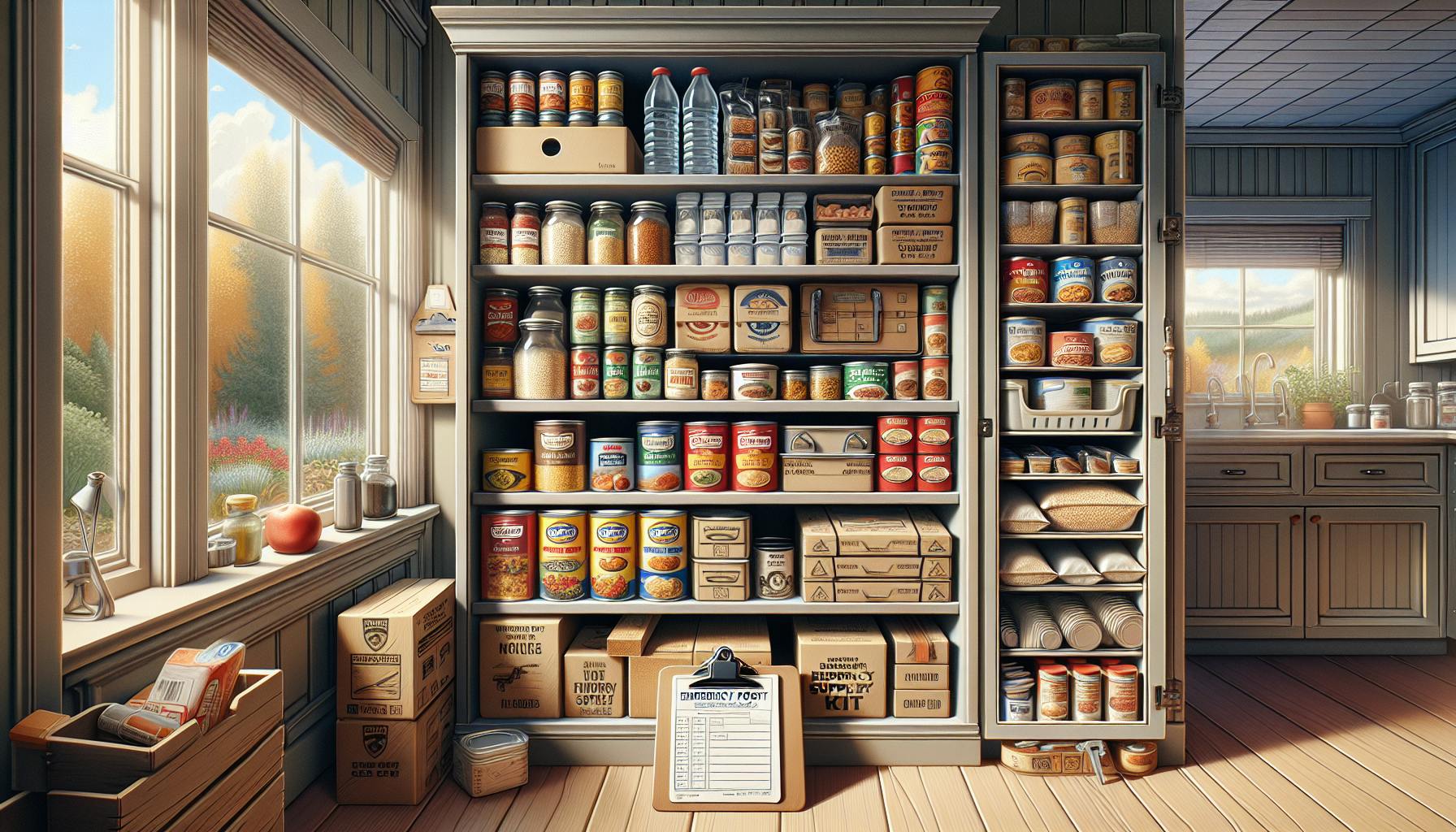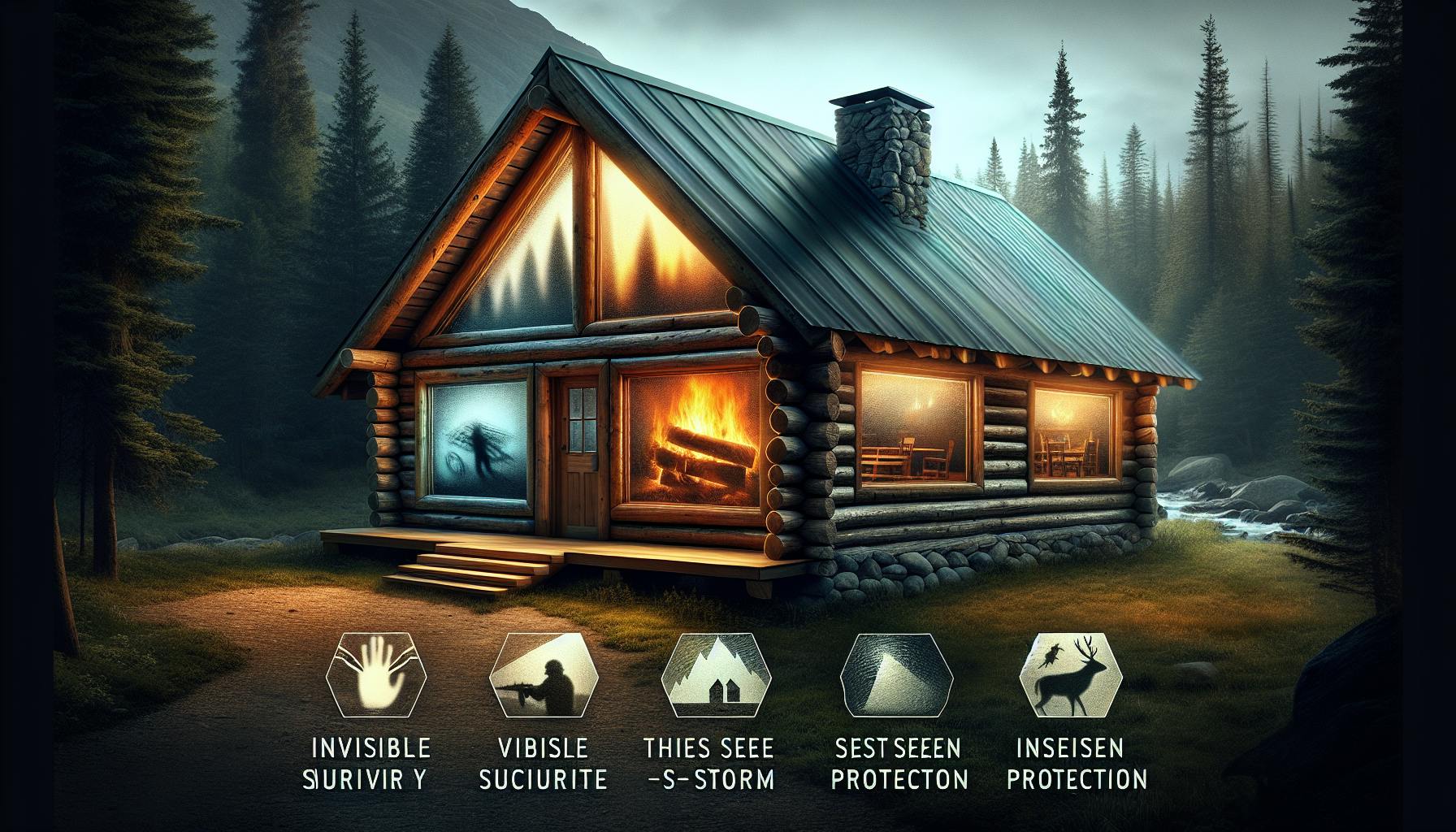Wise preparation for emergency situations often involves storing survival foods.
This article provides key strategies for maximizing shelf life when stockpiling survival foods, ensuring you can rely on your emergency food supply when you need it most.
You'll learn optimal storage conditions, the best storage containers, effective rotation practices, and how to build a robust 25-year food supply to see your family through any crisis.
Introduction to Wise Survival Foods Storage
This article provides tips on properly storing survival foods to maximize shelf life. We'll cover ideal storage conditions, recommended containers, and rotation strategies.
Understanding the Importance of Wise Food Storage Shelf Life
Having a long shelf life is critical for survival foods since they need to sustain you when access to fresh foods is limited during emergencies. Foods like freeze-dried meals, canned goods, rice, beans, powdered milk, and more are designed to last years if stored properly. Monitoring expiration dates and conditions helps ensure no nutrients or textures degrade over time.
It's wise to understand if the 25-year shelf life claimed by some emergency food kits requires certain storage protocols to achieve. You want your survival food stash to outlive any disruptions and be there when you need it most.
Maximizing the Benefits of Proper Storage
Storing survival foods correctly keeps them safe for consumption longer while maintaining nutritional content, texture, and taste. Key tips include:
- Keeping foods in a cool, dark, and dry area around 55-70°F. Temperature fluctuations degrade food over time.
- Using airtight containers like food-grade plastic buckets or Mylar bags with oxygen absorbers. This prevents moisture and oxygen exposure.
- Rotating stock using a first-in-first-out system. Use up older products before newer ones.
- Inspecting containers periodically for signs of spoilage like color changes or texture differences.
Following proper protocols preserves your emergency food supply investment for the long run. It ensures nourishment exactly when crisis strikes.
What are the top 10 survival foods?
When building an emergency food supply, it is important to choose foods that have a long shelf life, provide nutrition, and are easy to store. Here are 10 of the best survival foods to keep in your pantry:
- Peanut butter - High in protein, peanut butter has a shelf life of 3-5 years when unopened. Look for natural peanut butter without hydrogenated oils.
- Whole-wheat crackers - Crackers made from whole grains have a longer shelf life than refined crackers. Pair with peanut butter for protein.
- Nuts and trail mixes - High in nutrition and calories, nuts and seeds can last 2-3 years when stored properly. Stick to raw nuts without added oils.
- Cereal - Choose whole grain cereals and store in airtight containers. Pair with shelf-stable milk for a balanced meal.
- Granola and protein bars - Look for soft granola bars over crisp bars, which can become stale. Check labels for at least 5g of protein.
- Dried fruits - Dried fruits like apricots and raisins retain most of their nutritional value and can last up to a year when stored properly.
- Canned meats - Canned tuna, salmon, chicken, and turkey can provide protein and last 2-5 years in the pantry. Choose cans with pull tabs for emergencies.
- Canned vegetables - Canned goods like carrots, peas, and green beans have long shelf lives. Choose low-sodium options packed in water.
- Honey - With an indefinite shelf life, honey is packed with nutrients. Store in cool, dry place.
- Rice - White, jasmine, and basmati rice can last up to 30 years when kept dry and sealed. Brown rice has shorter 6 month shelf life.
Focusing your emergency food supply on shelf-stable, nutrient-dense foods can help prepare you for disasters. Consider creating a rotating stock so nothing expires or goes to waste.
What foods should I stockpile for survival?
When building your emergency food supply, focus on nutrient-dense non-perishable foods that will provide sustenance during a crisis. Here are some of the best survival foods to stockpile:
Canned and Dried Proteins
Canned varieties of meat, beans, fish, and poultry can last 2-5 years when properly stored. These are excellent sources of protein and nutrients. Some good options include:
- Canned chicken, tuna, salmon, sardines
- Canned baked beans, kidney beans, chickpeas
- Beef stew, chili with meat
- Wise Company emergency food kits with meat servings
Dried beans and TVP (textured vegetable protein) also store well long-term.
Canned Fruits and Vegetables
Fruits and veggies stored in cans, pouches or jars have a shelf life of at least 2 years. Great vitamin-rich choices are:
- Canned tomatoes, pumpkin, sweet potatoes
- Canned peaches, pears, applesauce
- Canned carrots, spinach, green beans
- Canned vegetable and fruit juices
Grains and Comfort Foods
Grains like rice, quinoa, pasta, and oats are versatile, non-perishable carb sources. Some other storable comfort foods include:
- Whole grain cereals and granola
- Dried pasta and rice varieties
- Crackers, pretzels, trail mixes
- Peanut butter and nut butters
When building your emergency food supply, focus on nutrient-sources that provide energy and keep well for years. The Wise Company offers excellent 25-year emergency food kits to feed a family. Their servings contain a balance of proteins, fruits, vegetables and grains to sustain you through any disaster.
How long does wise survival food last?
Wise Company offers high-quality survival food with an exceptionally long shelf life. Their foods are designed to last up to 25 years when stored properly. This gives you the peace of mind of knowing you have an emergency food supply that will be there when you need it, even decades into the future.
There are a few key factors that allow Wise foods to achieve such impressive shelf lives:
- Careful ingredient selection - Wise chooses ingredients like freeze-dried meats, fruits, vegetables, grains and legumes that maintain nutritional value and taste for many years.
- Oxygen absorbers - Small packets are included in every food bucket to absorb oxygen and prevent oxidation that leads to spoilage.
- Mylar pouches - Each food serving is packed in a high-quality mylar pouch that blocks light, moisture and oxygen from getting in.
- Food-grade buckets - The mylar pouches are stored in food-grade plastic buckets that further protect the food from elements like light, heat and pests.
Properly storing your Wise emergency food supply is also critical. Keep buckets stored in a cool, dark place like a basement or closet. Avoid temperature fluctuations and exposure to sunlight or moisture. Following the included storage guidelines will ensure your food lasts for the full 25-year shelf life.
With high-quality ingredients and packaging combined with proper storage methods, you can rely on Wise Company to deliver tasty, nutritious emergency food that will outlast even the longest disruptions when crisis strikes. Their exceptional 25-year shelf life brings confidence that your food supply will be there when you need it.
What is the best food to eat to survive?
When building an emergency food supply, it's important to focus on nutrient-dense foods that will provide long-lasting energy and key vitamins and minerals. Some of the best survival foods include:
- Beans, lentils, chickpeas: These legumes are packed with plant-based protein, fiber, and essential nutrients. They have a long shelf life when stored properly. Canned or dried beans are convenient options.
- Nuts and seeds: High in protein, healthy fats, and vitamins/minerals. Nuts and seeds like almonds, walnuts, sunflower seeds, etc. are compact sources of energy.
- Canned fish: Fish like salmon, sardines, and tuna are excellent sources of omega-3s and protein. Canned varieties store well.
- Whole grains: Brown rice, oats, quinoa, and other whole grains provide complex carbs, fiber, and B vitamins. They offer sustained energy.
- Powdered milk and eggs: Dried dairy products provide protein, calcium, and other nutrients. Reconstitute with water when needed.
- Fruits and veggies: Canned or freeze-dried fruits/veggies like carrots, sweet potatoes, and berries add key vitamins/minerals.
When building your emergency food supply, focus on nutrient-dense, non-perishable foods that align with your tastes and dietary needs. Diversify across food groups to meet nutritional requirements. Prioritize canned goods, dried foods, and other items with longer shelf lives. Test and rotate items to maximize freshness.
sbb-itb-b932644
Optimizing Storage Conditions for Extended Shelf Life
The right temperature, light exposure, and humidity levels are key for survival food storage. Maintaining ideal conditions helps prevent spoilage and extend the shelf life of wise survival foods.
Maintaining Ideal Temperature Ranges
Storing survival foods between 40-70°F helps prevent spoilage from heat or freezing. Temperatures outside this range can damage food quality over time. The optimal temperature for long-term storage of Wise Company Emergency Food Supply 120 Servings is 60-70°F. Consider storing emergency food supplies in a basement, pantry, or temperature-controlled storage area. Monitoring conditions with a thermometer helps ensure temperatures remain in the ideal 40-70° range.
Controlling Light to Preserve Nutrients
Exposure to light can degrade the nutritional value of survival foods over time. Storing emergency supplies in opaque containers helps minimize light exposure and preserve nutrients. For example, the 25-year emergency food supply from Wise Company comes packaged in thick plastic buckets that prevent light degradation. You can further protect against light by storing opaque containers of survival foods in a dark basement, closet, or cabinet area.
Regulating Humidity for Wise Food Storage
Keeping humidity below 70% helps prevent moisture damage to survival foods. If humidity is an issue, consider using desiccants or oxygen absorbers in storage containers. Storing emergency foods in a dry basement or using dehumidifiers to regulate humidity around 70% can help. The Wise Company packages their Emergency food supply for family of 4 products with oxygen absorbers to protect against humidity during the 25-year shelf life. Monitoring conditions with a hygrometer can help ensure you maintain optimal humidity levels for long-term wise survival foods storage.
Choosing the Best Containers for Emergency Food Storage
When storing emergency food supplies, it's important to use containers that protect against pests, moisture, oxygen, and light to maximize shelf life. The best options include:
Utilizing Opaque Plastic Buckets for Wise Storage
- 5-7 gallon plastic buckets with gamma seal lids provide easy access while keeping food sealed.
- Stackable and mobile for compact, organized storage.
- Opaque buckets prevent light exposure.
Protecting with Mylar Bags and Oxygen Absorbers
- Mylar bags create an airtight barrier to block oxygen and moisture.
- Use oxygen absorbers inside mylar bags to remove oxygen and extend shelf life.
- Mylar reflects light, keeping food fresher longer.
Sealing in Freshness with Vacuum-Sealed Bags
- Vacuum sealing removes air and prevents oxidation and freezer burn.
- Require special equipment like a vacuum sealer.
- Create an airtight seal for long term storage.
When stockpiling emergency food, proper storage using high quality containers is key to ensuring your wise survival foods maintain quality and safely last for years.
Implementing Rotation Strategies to Ensure Freshness
Rotating your food storage is critical to ensuring you have fresh, safe emergency supplies when you need them most. Here are some tips for implementing effective rotation strategies:
Effective Date Labelling for Food Rotation
- Clearly label all food containers and bags with the purchase or pack date. Use a permanent marker that won't rub off.
- Establish a standard date format, like MM/DD/YY, and stick to it for consistency.
- Place labels in an obvious spot like the top or front of the container.
Diversifying Inventory Locations to Promote Rotation
- Store food supplies in different areas like the pantry, basement, garage, etc.
- When restocking, pull from the location with the oldest inventory first. This naturally creates a first-in, first-out rotation.
- Take note of locations nearing expiration dates during routine checks. Use them up before newer inventory.
Conducting Yearly Reviews to Prevent Waste
- Set calendar reminders to check all food storage areas at least yearly.
- Review dates and organize inventory from oldest to newest during checks.
- Immediately use up any items approaching expiration dates to prevent having to throw them out.
Establishing rotation practices takes some extra effort upfront, but saves money and ensures you have reliable emergency food when needed most. Following first-in, first-out methods, diversifying storage locations, labeling clearly, and checking routinely are wise ways to maintain fresh wise survival foods.
Building a 25-Year Emergency Food Supply
A wise emergency food supply starts with understanding the dietary needs of your family and calculating the required calories, nutrients, and servings per person. When building a long-term 25-year supply, focus on nutrient-dense foods with a long shelf life.
Calculating the Emergency Food Supply for a Family of 4
- Estimate 2,000 calories per adult per day and 1,600 calories per child. Total for a family of 4 is 7,200 calories.
- Plan for essential macros like protein, carbs, fiber. Prioritize hearty grains, beans, lentils.
- Allow for some treat foods but focus on nutrition. Vitamins, minerals important.
- Calculate number of servings needed for 25 years based on calories and family size. Aim for at least 120 servings.
Selecting the Best Emergency Food Supply Options
- Choose shelf-stable foods that meet nutritional needs without refrigeration.
- Prioritize calorie-and nutrient-dense foods like grains, legumes, nuts, dried fruits.
- Ensure variety and tailor to family preferences within nutritional guidelines.
- Consider food allergies, health conditions. Accommodate specialized diets.
- Sample and test foods before fully stocking 25-year supply.
Maintaining a Wise Company Emergency Food Supply of 120 Servings
- Store emergency food supply in opaque buckets, Mylar bags with oxygen absorbers.
- Check and continually replace expired or used foods.
- Conduct yearly reviews, sampling foods for quality.
- Rotate stock, using and replacing food before expiration.
- Store in cool, dark place to maximize shelf life of 25 years.
Conclusion: Ensuring Long-Term Survival with Wise Food Choices
Properly storing survival foods is key to maintaining quality and extending shelf life. By keeping foods in ideal conditions - cool, dry storage around 40-70°F with low humidity and opaque containers - you can prevent spoilage and waste.
Recapping Key Strategies for Wise Survival Foods Storage
When storing survival foods like Wise Company's products, follow best practices:
- Date label containers and use a first-in-first-out system to rotate inventory. This prevents expiration and waste.
- Spread inventory between multiple locations like basements, garages, and pantries. This protects against damage or loss.
- Inspect storage areas annually and replace any compromised containers or expired products. An annual review maintains usable inventory.
By understanding ideal storage conditions and implementing inventory best practices, your emergency food supply will remain intact and safe for consumption when you need it most.


